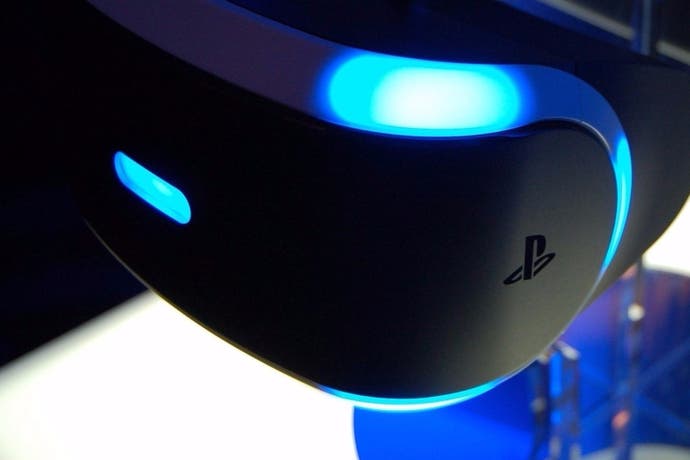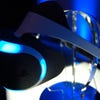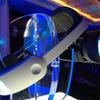In Theory: Does PS4 offer VR its best chance at success?
Sony has mainstream penetration and the cheapest hardware - but can it deliver the quality?
The battle lines are drawn. 2016 is the year in which the big players of the virtual reality space - HTC Vive, Oculus Rift and PlayStation VR - finally make a move on a compelling but still uncertain market. A lot is at stake for each to make a great first impression to buyers; from the quality of the games being shown, to the hardware being used, and in particular the notion of using a headset at all. Of all three contenders though, it's Sony that is perhaps best placed to bring virtual reality to genuine mainstream success.
A big factor in this is pricing. Oculus has already shown its hand recently at £500, which will buy you the headset, sensor and remote, plus an Xbox One pad and two games. HTC's technically more ambitious Vive is more expensive still at £689. However, for each approach this isn't the end of the expenditure, and to make any use of these headsets you'll also need a PC with decent specs - where a GTX 970 paired with an i5-4590 CPU is Oculus' recommendation. It's a fine fit for existing PC enthusiasts, but as a barrier for entry for those coming in fresh, these two components alone currently chew up another £400 of your budget. Add in the necessary power supply, motherboard and RAM, and it's a much taller bill than many will be willing to pay.
Sony's PlayStation VR has several big advantages, then. A PS4 is of course far cheaper than a PC of this spec - a £270 unit with an already wide install base that offers a standardised level of power developers can target when optimising VR games. Meanwhile, Sony states the cost of its own VR kit will be "akin to a new gaming platform", suggesting it veers closer to PS4's original £350 launch price rather than its £500+ competitors. Of course, there is no such thing as a free lunch when it comes to pricing technology: we shouldn't expect a hardware design as advanced or refined as the competitors'. But we've seen it and used it, and the sense of immersion is there. It has the wow factor, and the balance between price and hardware is better tuned towards a mainstream audience.
The second advantage for Sony is how a headset might fit into day-to-day use for most PS4 users. For example, Valve's recent SteamVR developer conference hosted 12 games, 11 of which requiring the user to be standing and to have some degree of 'travel' within the room. No doubt, there will be seated games for this platform, but to get the most out of the whole catalogue of VR software you will need space, suggesting the living room will end up being the home of virtual reality experience. Living room PCs are on the rise, but it's clear PS4 has the better penetration here to make this work universally.
Next, there's the social angle. Many of the SteamVR titles we saw (of which most are also coming to PlayStation VR) work best when the experience is shared with nearby friends. Job Simulator is a great case in point - a game that invites friends to laugh at your mistakes as you create chaos in the kitchen. Crucially, the player's viewpoint is mirrored to a HDTV thanks to PlayStation VR's external processor, but the availability of this option on Oculus and Vive isn't entirely clear. We've seen debug screens running on secondary monitors, but no system-wide standard has been shown so far.
All told, the price, hardware and positioning of PS4 gives Sony a big chance to propel VR to the mainstream in higher volume and with a much larger impact than its competitors. It even has previous with high-accuracy motion controllers like PlayStation Move, a crucial part in making the most of a 3D space. But all this lays the groundwork for something far more important: the games. Sony's first party pedigree is strong, and there are plenty of exclusives to set it apart from the competition. But all of this does beg the question - does the PS4 itself have the horsepower to get the job done?
To answer this, we look back on four PlayStation VR demos sampled at last year's Paris Games Week. The first big attraction there was DriveClub VR, a game that stuck to 30fps for its regular console release, but targets 60fps via reprojection to achieve a fluid racing experience with a VR headset, interpolated up to 120Hz via asynchronous timewarp - effectively a frame-rate upscaler that warps the image based on the very latest motion data received from the headset. The actual experience of playing this unique build was a mixed one. On the one hand, it's the closest we'll ever get to driving a £200,000+ sports car at over 130mph while leaning out of a window for a quick peek around. (Perhaps for the best.)

Everything was catered for here, with a top-end steering wheel and pedals supplied as the default control method. Once buckled in with the headset and headphones too, it hammered home how close DriveClub VR was getting to the real thing. Of course, it'll be interesting to see how the experience holds up with a standard Dual Shock 4 in hand, but the head tracking alone gave us a real sense of presence within the car. Leaning forward and back, and turning around, we could examine every detail of its interior in a way that wasn't possible before.
It proved an utterly brilliant taster for what could come of a full product (even if the ability to stand bolt upright through the car roof broke the immersion a little). And technically speaking, Evolution Studios takes a very sensible approach to optimising for PlayStation VR's display to minimise the sense of nausea. In the October build we played, the game held up at a smooth 60fps per eye with no obvious frame drops, all of which helped to avoid a disconnect which might trigger a negative reaction.
Going from 30fps to 60fps doesn't come for free, but the team were keen to explain the nips and tucks taken in this VR build. For starters, physically-based lighting is still used across DriveClub VR's track, with global illumination in play too. However, the deferred renderer used in the standard PS4 game is traded out for a forward rendering approach, lowering the computational burden. In practical terms, this means we lose atmospheric effects like a dynamic time of day, and also the distinctive rolling cloud simulation. As a compromise, races can still be set to a specific time prior to a race, with the team discussing 'baking in' shadows in order to relieve further strain on the GPU. It's possible this move could free up processor power to reinstate other lost features, such as the rear-view mirror - another a omission in order to keep a hold on 60fps.
This VR build also renders at a native resolution below 1920x1080 per eye. It's a reasonable cutback though, given at a full 1080p per eye this would precisely double the pixel count of the regular game. The good news is, we're told by producer Paul Rustchynsky that the overall combined pixel count for both eyes adds up to a number much higher than regular 1080p. It's fair to say the curtailing in resolution here leaves Driveclub looking softer than we'd like, especially with each display planted so close to our line of sight. On a more positive slant, performance is quite rightly the priority here, and the game itself can be explored in an unprecedented way.
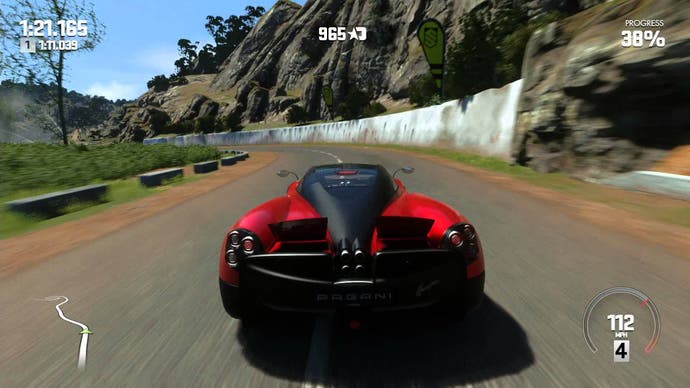
It's a great example of an existing AAA franchise making a leap to PlayStation VR, but what about experiences custom-tailored for it? One of the more compelling demos shown was The London Heist, a simple on-rails shooter that pitted us against pursuing gangs while driving full-pelt down a motorway. The hook is in the controls; a Move controller is planted in each hand, and pulling either trigger lets you grab objects around the vehicle's dash. As a passenger, the job is to grab a gun in front of you, fire away, and reload by physically grabbing from a stash of magazines and raising it to the butt of the firearm.
It's a wonderfully intuitive idea, but one that would be dull without the VR component to back it. Here the chaos completely engulfs your vision, and each hand movement is simulated by motion controls in a convincing 1:1 fashion. This means you can hook your wrist around the window to haphazardly spray the remainder of a clip, and even raise the gun to use its ironsights. This absolutely works as a sit-down arcade-style experience, and all it needs is its content fleshing out in order to transition to a full product. The chances are we've only seen a small section of what this title has to offer.
The idea of filling your view, much like an IMAX screening of a film, has an apparent power in games too. This became agonisingly clear in a PlayStation VR title called "Kitchen" - a grim horror slice developed by Capcom. In this we played an entirely passive observer to a gruesome scene, bound to a chair at the centre of a dark, ruined kitchen. The only interactivity we had was in moving our rope-tied hands around with two Move controllers, and turning around while a zombie-like creature tip-toed about, just out of sight with a bloody machete.
We were warned in advance to raise a hand if it became too much, and a nearby PR would step in. We decided to see it through, but the reason for caution became pretty obvious after a morbid 10-minute spectacle. With VR, there is simply no way to put such an unpleasant experience at arm's length, as you might during a movie by glancing to one side. It saturates your field of view completely (and indeed your hearing as well), until you decide you've reached a limit. The ability to create a massive viewable screen space - like sitting in your own IMAX theatre - also has an interesting application in titles such as Super Stardust Ultra; developer D3T [Update: studio name corrected - apologies for any confusion!] is known to be experimenting with VR. But here it's applied to truly harrowing effect.
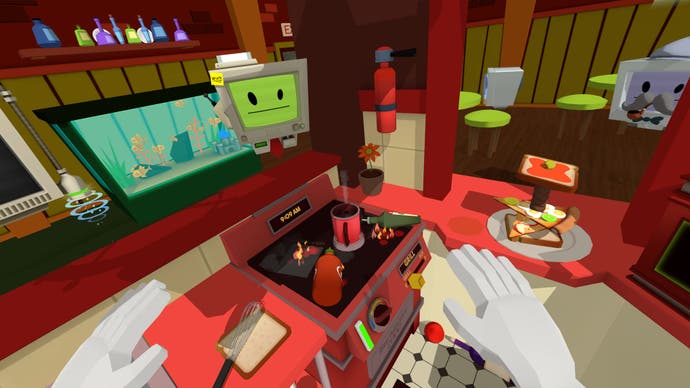
The last demo in Sony's Paris showroom was Battlezone, developed by Rebellion as a high-octane VR successor to the 1980 Atari classic. The idea is, again, simple enough; pilot a mech around an arena with standard Dual Shock 4 controls for movement and aiming, and destroy anything that approaches. Unfortunately, this is where the notorious nausea that surrounds VR coverage started to kick in - and after five minutes we had to call it to an end. It's possible the dips from 60fps in this early build triggered it, or even the use of a standard controller (where most other demos relied on Move motion controls) - but this marked the first time we faced the issue while at the show.
All of which leads back to the importance of first impressions. John Carmack, most notable in the VR space for his work on Oculus Rift, has made clear his concern about sub-optimal VR solutions "poisoning the well" for the movement at large. Even speaking to developers of these PlayStation VR titles, we found a similar level of anxiousness to get this absolutely right for launch. Sony has the biggest opportunity to make VR work for a mainstream audience, but it's clear it comes paired with an awesome level of responsibility.
If the price is right, PlayStation VR doesn't need to match Vive or Oculus on each technical bullet point. The headset must simply be able to deliver a great sense of presence in a virtual space and play host to high quality games. From what we've seen of Sony's demos to date, it already has these bases covered with the likes of DriveClub VR and Capcom's intense Kitchen segment. These are experiences we can't get anywhere else, and it's encouraging that PS4's processing grunt seems up to the challenge too. Furthermore, we played just a quartet of titles - many, many more are in development.
It's a big year for virtual reality, and there are no certainties for its success. But where gaming is concerned, Sony may well be offering the only truly mainstream solution: a potentially cheaper HMD paired with a fixed console platform that will only go down in price.
